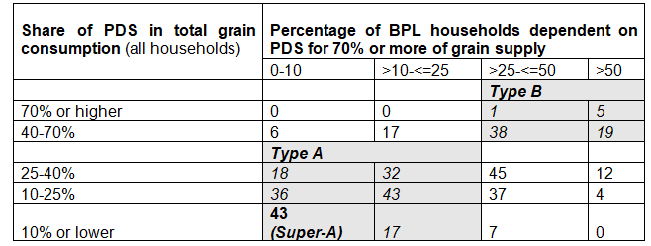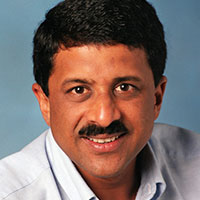Should food subsidies – currently availed in the form of subsidised cereals – be given out in the form of cash instead? In this post, Krishna and Agrawal contend that rather than asking this binary question, it might be more cost-effective and welfare-enhancing to consider: where is PDS, and where might cash be, the better policy response for serving the same need?
Should food subsidies – currently availed in the form of subsidised cereals – be given out in the form of cash instead? Some analysts have held out in favour of the cash alternative (for instance, Gulati and Saini 2015, Kotwal, Murugkar, and Ramaswami 2011, and Muralidharan 2011); others have argued that the food security of the country’s poorer citizens is better ensured by the existing public distribution system (PDS) (Dreze and Khera 2013, Khera 2011, 2014, and Sinha 2015).
The debate has been waged in either-or terms: Either, PDS should be entirely replaced by cash transfers, or it should remain entirely in-kind.
But individuals and families do not live in these either-or realities. Hardly any family gets its food entirely from the market or entirely from PDS. The share of PDS-supplied staples, rice and wheat (hereafter referred to as grain), varies. The richest quintile gets 6% of its grain consumption from PDS, and the poorest quintile gets a little less than 50% of its consumption from PDS, relying upon the market for the rest. The average rural household gets 30% of its grain consumption from the family farm, 20% from PDS, and the rest from the market.
Two parallel supply chains are in operation. Households have to deal with both supply chains.
The relative shares of the PDS and the market supply chains vary considerably from one state to another. We considered two metrics of PDS-dependence for this part of the analysis. The second round of the India Human Development Survey (IHDS-2), undertaken over 2011-12, provided the data for this analysis. First, we defined heavily PDS-dependent households as those who get 70% or more of their grain supply from PDS. We find that the percentage share of heavily dependent households overall is greatest in Himachal Pradesh (comprising 33.2% of the state’s population) and lowest in West Bengal (1.7%). Separately, we looked at below-poverty-line (BPL) households, considering their extents of PDS-dependence. For these households, PDS is both a food supply chain and a source of public subsidies. The share of heavily PDS-dependent BPL households, 22% across the nation, is similarly highest in Himachal Pradesh (45.3%), with Jammu & Kashmir in second place (39.8%), and lowest in West Bengal (3.3%), followed by Andhra Pradesh (7.6%).
Replacing the part of the supply chain that provides less than 2% of all grain consumed is a very different proposition than replacing a part that provides one-third of all grain consumed in a state. Introducing a cash alternative in West Bengal has very different practical implications compared to implementing the same alternative in Himachal Pradesh.
States are, however, still too large for this analysis. In relation to our two criteria of PDS-dependence, we found a great deal of variation across districts within states:
(a) share of PDS in total district consumption of foodgrains (overall dependence), and
(b) share of BPL families getting 70% or more of foodgrain supply from PDS (heavily-dependent BPL households).
Administratively, too, the machinery of implementing PDS is centred on districts. We consider the district the more appropriate unit for this analysis.
Table 1 classifies districts along the two criteria. Each cell of the table gives the number of districts that have the corresponding values on the two axes.
Table 1. Degrees of PDS dependence in districts
(Number of districts)
 Note: IHDS-2 was administered in only 380 of India’s more than 700 districts. The analysis presented here is illustrative of a method for classification and prioritisation without being comprehensive. In order to undertake a comprehensive district-by-district analysis, recourse will have to be taken to household-level census data.
Note: IHDS-2 was administered in only 380 of India’s more than 700 districts. The analysis presented here is illustrative of a method for classification and prioritisation without being comprehensive. In order to undertake a comprehensive district-by-district analysis, recourse will have to be taken to household-level census data. Notice the split between two extreme types of districts. In Type A districts, depicted toward the bottom left of the table, less than 40% of all grain consumed comes from PDS and less than 25% of BPL households are heavily PDS-dependent. These are ‘low PDS-dependence districts’.
Within Type A, there is a sub-category of ‘super-low PDS-dependence districts’: those 43 districts, depicted in the bottom left cell, where less than 10% of grain supply is obtained through PDS and less than 10% of BPL households are heavily PDS-dependent. We classify these districts as the Super-A type.
At the other extreme, toward the top right-hand side of the table, are the districts of Type B. These are ‘high PDS-dependence districts’.
Super-A districts and those of Type B are polar opposites in terms of their relationship with PDS. Residents of Super-A districts already obtain 90% or more of their grains from outside the PDS. They should be more ready and willing to switch to cash compared to people in Type B districts, who are more heavily PDS-dependent. The more copious market pipeline that exists in Super-A districts could be expanded with less difficulty compared to what is possible and likely in Type B districts.
Making informed choices
Where the situation is as heterogeneous as it is here – with the extent of PDS-dependence across districts ranging from 10% to 90% – it needs to be questioned whether adopting a uniform policy response represents the best use of the taxpayers’ money, or whether a variable geometry of policy responses may be more effective. Instead of asking the binary question – cash or PDS – it might be more cost-effective and welfare-enhancing to pose a different question: where is PDS, and where might cash be, the better policy response for serving the same need?
We propose initial trials of the cash alternative in a small group of 6-8 Super-A districts.1 If workable plans get developed that ensure food security, especially of poorer residents, in this subgroup of districts, then, and only then, should the cash alternative be extended to any other district. The worth of any cash alternative has yet to be demonstrated in practice. All we have seen are half-hearted or aborted experiments.
Based on the learning of the past, some design principles are important while implementing these trials in the initial group of super-A districts.
- Optional: States should have the right to opt into (or stay out of) the cash alternatives. Families within these states should also have the right to opt between food and cash. They should also have the right to reverse their decisions. The choice for a family must not be made by someone else.
- Retain and strengthen the existing network of PDS outlets, making them partners, and not adversaries, of the new system.
- Vouchers: Food subsidies to BPL households should be given out, in the first instance, in the form of vouchers, distributed through the existing network of PDS outlets, and providing the seller with an equal commission (as if they were giving out rice or wheat).
- Inflation-indexed: Food vouchers should be inflation-indexed cash entitlements, equal in value to X kg of wheat or rice at the prevailing market prices.
- Equal value: The value of the voucher should not be greater or smaller than the in-kind subsidy. That is necessary for a fair testing of the alternative.
- Information campaigns: A far-reaching public information campaign must be run in the selected districts during the 3-6 months prior to the launch of the trial.
Let the choice of depositing vouchers with banks rest with individuals and families. Where people have confidence in banks and when they have gained familiarity with banking procedures, the amount of the cash subsidy that flows through banks will automatically increase. Making it an imposition reduces choice, lowering welfare. Loading additional goals onto the system – linking it with banks, linking it with Aadhaar2, etc. – can result in taking one’s eye off the main goal.
Public information campaigns are essential prerequisites. A widespread public information campaign preceding the introduction of the cash alternative helps bring clarity and purpose to the undertaking, enabling people to make considered decisions. Fearmongering and rumours are likely to colour people’s views and influence their choices – if an effective information campaign is not undertaken.
Setting up the required structures and instituting the appropriate procedures in the first set of 6-8 pilot districts will take at least 2-3 years. Change will occur gradually. Many people will wait and watch. Even in the first set of districts, people will not all at once switch to cash. It can reasonably be expected that the PDS will continue for a long time even in districts where the cash alternative is implemented (another reason why the network of PDS shops needs to be protected).
There might well be some among the initial districts where the cash alternative is preferred by the majority, and other districts where the majority prefer to remain with the PDS. It is hard to predict what people will prefer. Instead of making the choice on their behalf, let us be respectful and leave it to them.
A longer version of this article will appear in Economic & Political Weekly.
Notes:
- The 43 Super-A districts include one district of Haryana; 5 districts of Punjab; 8 districts of Uttar Pradesh; 4 districts of Delhi; 2 of Bihar; 4 of Rajasthan; 1 district of Jharkhand; 5 of West Bengal; 4 districts in Nagaland; 4 in Madhya Pradesh; and 5 districts in Gujarat.
- Aadhaar or Unique Identification number (UID) is a 12-digit individual identification number issued by the Unique Identification Authority of India (UIDAI) on behalf of the Government of India. It captures the biometric identity – 10 fingerprints, iris and photograph – of every resident, and is meant to serve as a proof of identity and address anywhere in India.
Further Reading
- Drèze, Jean and Reetika Khera (2013), “Rural poverty and the public distribution system”, Economic and Political Weekly, 47(45–46): 55–60.
- Gulati, A and S Saini (2015), ‘Leakages from public distribution system (PDS) and the way forward’, ICRIER (Indian Council for Research on International Relations) working paper No. 294, New Delhi.
- Khera, Reetika (2011), “Revival of the public distribution system: Evidence and explanations”, Economic and Political Weekly, 46(44–45): 36–50.
- Khera, Reetika (2014), “Cash vs. in-kind transfers: Indian data meets theory”, Food Policy, 46:116–128.
- Kotwal, Ashok, Milind Murugkar and Bharat Ramaswami (2011), “PDS Forever?”, Economic and Political Weekly, 46(21): 72–76.
- Muralidharan, K (2011), ‘Piloting and evaluating e-PDS and cash transfer options for Improved Food Security in Bihar’, Paper presented at the Bihar Growth Conference, Patna.
- Sinha, Dipa (2015), “Cash for Food-A Misplaced Idea”, Economic and Political Weekly, 50(16): 17–20.




 31 October, 2018
31 October, 2018 





Comments will be held for moderation. Your contact information will not be made public.